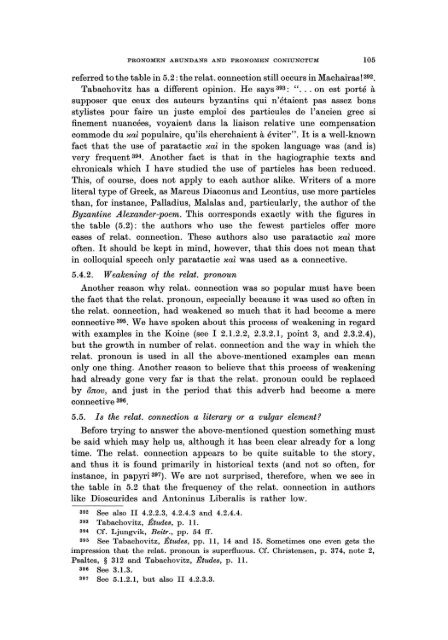Pronomen Abundans and Pronomen Coniunctum. A ... - DWC
Pronomen Abundans and Pronomen Coniunctum. A ... - DWC
Pronomen Abundans and Pronomen Coniunctum. A ... - DWC
You also want an ePaper? Increase the reach of your titles
YUMPU automatically turns print PDFs into web optimized ePapers that Google loves.
PRONOMEN ABUNDANS AND PRONOMEN CONIUNCTUM 105<br />
referred tothe tab Ie in 5.2: the relat. connection still occurs in Machairas!392.<br />
Tabachovitz has a different opinion. He says 393: " . .. on est porté à<br />
supposer que ceux des auteurs byzantins qui n'étaient pas assez bons<br />
stylistes pour faire un juste emploi des particules de l'ancien grec si<br />
finement nuancées, voyaient dans la liaison relative une compensation<br />
commode du "at populaire, qu'ils cherchaient à éviter". It is a well-known<br />
fa ct that the use of paratactic "at in the spoken language was (<strong>and</strong> is)<br />
very frequent 394. Another fact is that in the hagiographic texts <strong>and</strong><br />
chronicals which I have studied the use of particles has been reduced.<br />
This, of course, does not apply to each author alike. Writers of a more<br />
literal type of Greek, as Marcus Diaconus <strong>and</strong> Leontius, use more particles<br />
than, for instance, Palladius, Malalas <strong>and</strong>, particularly, the author of the<br />
Byzantine Alex<strong>and</strong>er-poem. This corresponds exactly with the figures in<br />
the table (5.2): the authors who use the fewest particles offer more<br />
cases of relat. connection. These authors also use paratactic "at more<br />
often. It should be kept in mind, however, that this does not mean that<br />
in colloquial speech only paratactic "at was used as a connective.<br />
5.4.2. Weakening ot the relat. pronoun<br />
Another reason why relat. connection was so popular must have been<br />
the fact that the relat. pronoun, especially because it was used so of ten in<br />
the relat. connection, had weakened so much that it had become a mere<br />
connective 395. We have spoken about this process of weakening in regard<br />
with examples in the Koine (see I 2.1.2.2, 2.3.2.1, point 3, <strong>and</strong> 2.3.2.4),<br />
but the growth in number of relat. connection <strong>and</strong> the way in which the<br />
relat. pronoun is used in all the above-mentioned examples can mean<br />
only one thing. Another reason to believe that this process of weakening<br />
had already gone very far is that the relat. pronoun could be replaced<br />
by onov, <strong>and</strong> just in the period that this adverb had become a mere<br />
connective 396.<br />
5.5. Is the relat. connection a literary or a vulgar element?<br />
Before trying to answer the above-mentioned question something must<br />
be said which may help us, although it has been clear already for a long<br />
time. The relat. connection appears to be quite suitable to the story,<br />
<strong>and</strong> thus it is found primarily in historical texts (<strong>and</strong> not so of ten , for<br />
in stance, in papyri 397). We are not surprised, therefore, when we see in<br />
the tab Ie in 5.2 that the frequency of the relat. connection in authors<br />
like Dioscurides <strong>and</strong> Antoninus Liberalis is rather low.<br />
392 See also II 4.2.2.3, 4.2.4.3 <strong>and</strong> 4.2.4.4.<br />
393 Tabachovitz, Études, p. 11 .<br />
394 Cf. Ljungvik, Beitr., pp. 54 ff.<br />
395 See Tabachovitz, Études, pp. 11, 14 <strong>and</strong> 15. Sometimes one even gets the<br />
impression that the relat. pronoun is superfluous. Cf. Christensen, p. 374, note 2,<br />
Psaltes, § 312 <strong>and</strong> Tabachovitz, Études, p. 11.<br />
396 See 3.1.3.<br />
397 See 5.1.2.1, but also II 4.2.3.3.
















